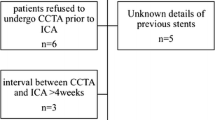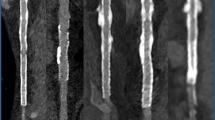Abstract
Coronary computer tomographic angiography (CCTA) for screening intra-arterial vessel disease is gaining rapid clinical acceptance in recent years, but its use for such assessments in metal-stented vessel segments is very limited due to blooming artifacts introduced by the metal. However, vessel segments treated by the polymeric everolimus-eluting bioresorbable vascular scaffolds (Absorb) are readily monitored for intravascular disease over time with CCTA. The data on the accuracy of multi-detector computed tomography (MDCT) in patients treated with Absorb is still sparse. Results on 5 Japanese case studies from ABSORB EXTEND are presented here. Five patients were treated with Absorb, and follow-up angiography was conducted at 8 to 14 months as per routine site standard of practice. 320-row MDCT scan was performed within 1 month before the angiography. By MDCT, all Absorb-treated lesions were clearly evaluated and restenosis were not observed. Minimal diameter and % diameter stenosis were similar between MDCT and quantitative angiography (2.07 ± 0.13 vs. 2.03 ± 0.06 mm, P = 0.86, and 22.5 ± 5.0 vs. 21.5 ± 4.5 %, P = 0.88, respectively). MDCT appears to be feasible and useful for evaluating lumen patency and vessel disease in segments implanted with Absorb at follow-up.


Similar content being viewed by others
References
Mark DB, Berman DS, Budoff MJ, Carr JJ, Gerber TC, Hecht HS, et al. ACCF/ACR/AHA/NASCI/SAIP/SCAI/SCCT 2010 expert consensus document on coronary computed tomographic angiography: a report of the American College of Cardiology Foundation Task Force on Expert Consensus Documents. Circulation. 2010;121:2509–43.
De Graaf FR, Schuijf JD, Van Velzen JE, Boogers MJ, Kroft LJ, de Roos A, et al. Diagnostic accuracy of 320-row multidetector computed tomography coronary angiography to noninvasively assess in-stent restenosis. Invest Radiol. 2010;45:331–40.
Mahnken AH. CT imaging of coronary stents: past, present, and future. ISRN Cardiol. 2012;2012:139823.
Ormiston JA, Serruys PW, Regar E, Dudek D, Thuesen L, Webster MW, et al. A bioabsorbable everolimus-eluting coronary stent system for patients with single de-novo coronary artery lesions (ABSORB): a prospective open-label trial. Lancet. 2008;371:899–907.
Serruys PW, Ormiston JA, Onuma Y, Regar E, Gonzalo N, Garcia-Garcia HM, et al. A bioabsorbable everolimus-eluting coronary stent system (ABSORB): 2-year outcomes and results from multiple imaging methods. Lancet. 2009;373:897–910.
Otsuka M, Tanimoto S, Sianos G, Kukreja N, Weustink AC, Serruys PW, et al. “Radio-lucent” and “radio-opaque” coronary stents characterized by multislice computed tomography. Int J Cardiol. 2009;132:e8–10.
Farooq V, Gomez-Lara J, Brugaletta S, Gogas BD, Garcìa-Garcìa HM, Onuma Y, et al. Proximal and distal maximal luminal diameters as a guide to appropriate deployment of the ABSORB everolimus-eluting bioresorbable vascular scaffold: a sub-study of the ABSORB Cohort B and the on-going ABSORB EXTEND Single Arm Study. Catheter Cardiovasc Interv. 2012;79:880–8.
Muramatsu T, Onuma Y, García-García HM, Farooq V, Bourantas CV, Morel MA, et al. Incidence and short-term clinical outcomes of small side branch occlusion after implantation of an everolimus-eluting bioresorbable vascular scaffold: an interim report of 435 patients in the ABSORB-EXTEND single-arm trial in comparison with an everolimus-eluting metallic stent in the SPIRIT first and II trials. JACC Cardiovasc Interv. 2013;6:247–57.
Boogers MJ, Broersen A, van Velzen JE, de Graaf FR, El-Naggar HM, Kitslaar PH, et al. Automated quantification of coronary plaque with computed tomography: comparison with intravascular ultrasound using a dedicated registration algorithm for fusion-based quantification. Eur Heart J. 2012;33:1007–16.
Osawa K, Miyoshi T, Sato S, Akagi N, Morimitsu Y, Nakamura K, et al. Safety and efficacy of a bolus injection of landiolol hydrochloride as a premedication for multidetector-row computed tomography coronary angiography. Circ J. 2013;77:146–52.
Carrabba N, Schuijf JD, de Graaf FR, Parodi G, Maffei E, Valenti R, et al. Diagnostic accuracy of 64-slice computed tomography coronary angiography for the detection of in-stent restenosis: a meta-analysis. J Nucl cardiol. 2010;17:470–8.
Acknowledgments
The authors thank all of the patients for their participation in this study.
Funding sources
This research received no grant from any funding agency in the public, commercial, or not-for-profit sectors.
Disclosure
Patrick W. Serruys is member of Advisory Board of Abbott Vascular. Alexandre Abizaid receives research grants from Abbott Vascular. Shigeru Saito receives consultancy from Terumo Corporation and receives remuneration from Abbott Vascular Japan, Medtronic, and Boston Scientific Japan. Yoshinobu Onuma is member of Advisory Board of Abbott Vascular Japan. Takeshi Kimura receives research funding from Abbott Vascular Japan and Terumo Corporation. Charles A. Simonton is a full time employee of Abbott Vascular. Kengo Tanabe receives consultancy from Terumo Corporation, Kaneka Medix Corporation and Zeon Medical receives remuneration from Abbott Vascular Japan. None of the other authors have conflicts of interest of declare. The ABSORB EXTEND single arm study is sponsored and funded by Abbott Vascular.
Author information
Authors and Affiliations
Corresponding author
Ethics declarations
Human and animal rights statement
We complied strictly with human and animal rights statement in this study.
Rights and permissions
About this article
Cite this article
Asami, M., Aoki, J., Serruys, P.W. et al. Feasibility of 320-row multi-detector computed tomography angiography to assess bioabsorbable everolimus-eluting vascular scaffolds. Cardiovasc Interv and Ther 31, 96–100 (2016). https://doi.org/10.1007/s12928-015-0353-1
Received:
Accepted:
Published:
Issue Date:
DOI: https://doi.org/10.1007/s12928-015-0353-1




